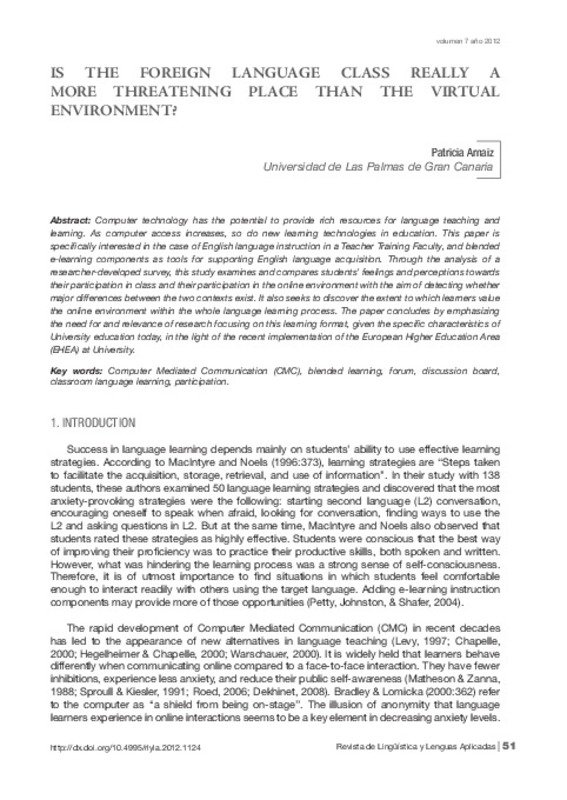Arnaiz, P., Peñate, M., Bazo, P. (2010). "El efecto de la planificación en la expresión oral en alumnos de primaria", Porta Linguarum 14: 181-195.
Ayres, R. (2002). Learner attitudes towards the use of CALL, Computer Assisted Language Learning 15/3: 241-249. http://dx.doi.org/10.1076/call.15.3.241.8189
Bradley, T. and Lomicka, L. (2000). "A case study of learner interaction in technology-enhanced language learning environments". Journal of Educational Computing Research 22/3: 247-368. http://dx.doi.org/10.2190/TCUA-3YUV-B1P5-26P3
[+]
Arnaiz, P., Peñate, M., Bazo, P. (2010). "El efecto de la planificación en la expresión oral en alumnos de primaria", Porta Linguarum 14: 181-195.
Ayres, R. (2002). Learner attitudes towards the use of CALL, Computer Assisted Language Learning 15/3: 241-249. http://dx.doi.org/10.1076/call.15.3.241.8189
Bradley, T. and Lomicka, L. (2000). "A case study of learner interaction in technology-enhanced language learning environments". Journal of Educational Computing Research 22/3: 247-368. http://dx.doi.org/10.2190/TCUA-3YUV-B1P5-26P3
Chapelle, C. (2000). Computers applications in second language acquisition. Cambridge: Cambridge University Press.
Chang, J. (2002). The mask mechanism: A study of anxiety, motivation and communicative competence of Korean learners of English in computer-mediated communication environments. Unpublished doctoral dissertation, The University of Manchester, Manchester, UK.
Dekhinet, R. (2008). "Online enhanced corrective feedback for ESL learners in higher education", Computer Assisted Language Learning 21/5: 409-425. http://dx.doi.org/10.1080/09588220802447669
Dewaele, J. M. (2005). "Investigating the Psychological and Emotional Dimensions in Instructed Language Learning: Obstacles and Possibilities". The Modern Language Journal 89/3: 367-380. http://dx.doi.org/10.1111/j.1540-4781.2005.00311.x
Dörnyei, Z. & Skehan, P. (eds.) (2002). Individual differences in second language acquisition. Amsterdam: John Benjamins.
Hegelheimer, V. and Chapelle, C.A. (2000). "Methodological issues in research on learnercomputer interactions in CALL". Language Learning & Technology 4/1: 41-59.
Kraemer, A. (2008). "Formats of distance learning", in S. Goertler & P. Winke (eds.) Opening doors through distance language education: Principles, perspectives, and practices. San Marcos, TX: Computer Assisted Language Instruction Consortium (CALICO), 11-42.
Leasure, A.R., Davis, L., and Thievon, S.L. (2000). Comparison of student outcomes and references in a traditional vs. World Wide Web-based baccalaureate nursing research course, Journal of Nursing Education 39/4: 149-154.
Levy, M. (1997). Computer-assisted language learning: Context and conceptualization. New York: Oxford University Press.
Lim, K. M. and Shen, H. Z. (2006). Integration of computers into an EFL reading classroom. ReCALL 18/2: 212-229. http://dx.doi.org/10.1017/S0958344006000528
MacIntyre, P. D. and Noels, K. A. (1996). "Using social-psychological variables to predict the use of language learning strategies", Foreign Language Annals 29/3: 373-386. http://dx.doi.org/10.1111/j.1944-9720.1996.tb01249.x
Martínez-Baztán, A. (2008). La evaluación oral: una equivalencia entre las guidelines de ACTFL y algunas escalas del MCER [Oral evaluation: an equivalence between ACTFL guidelines and some CEFR scales]. Unpublished doctoral dissertation. University of Granada, Granada, Spain.
Matheson, K. and Zanna, M.P. (1988). "The impact of computer-mediated communication on self-awareness". Computers in Human Behavior 4: 221-233. http://dx.doi.org/10.1016/0747-5632(88)90015-5
Mitchell, R. and Myles, F. (2004). Second language learning theories (2nd ed.). London: Arnold.
Ortega, L. (1999). "Planning and focus on form in L2 oral performance", Studies in Second Language Acquisition 21: 108-48. http://dx.doi.org/10.1017/S0272263199001047
Payne, J.S. and Ross, B.M. (2005). "Synchronous CMC, working memory, and L2 oral proficiency development", Language Learning and Technology 19/3: 35-54.
Payne, J.S., and Whitney, P.J. (2002). "Developing L2 oral proficiency through synchronous CMC: Output, working memory and interlanguage development", CALICO Journal 20/1: 7-32.
Petty, L. I., Johnston, J., and Shafer, D. (2004). "Distance education for adult learners". Retrieved March 1, 2006, from http://www.projectideal.org/pdf/handbook/DEHandbook3rdEdTEXT2!.pdf
Presby, L. (2001). 'Seven tips for highly effective online courses', Syllabus 14,17.
Roed, J. (2003). "Language learner behavior in a mutual environment", Computer Assisted Language Learning 16/2-3: 155-172. http://dx.doi.org/10.1076/call.16.2.155.15880
Sotillo, S. (2000). "Discourse functions and syntactic complexity in synchronous and asynchronous communication", Language Learning Technology 4/1: 82-119.
Sproull, L., and Kiesler, S. (1991). "Computers, network and work". Scientific American. Sept 1991, 116-123. http://dx.doi.org/10.1038/scientificamerican0991-116
Starr, P. (1997). "Computing our way to educational reform", The American Prospect 27: 50-60.
Swain, M. (1985). "Communicative competence: Some roles of comprehensible input and comprehensible output in its development", in S. Gass, and C. Madden (eds.) Input in Second Language Acquisition. New York: Newbury House, 235-256.
Swain, M. and Deters. P. (2007) "New Mainstream SLA Theory: Expanded and Enriched", Modern Language Journal 91: 820-836. http://dx.doi.org/10.1111/j.1540-4781.2007.00671.x
Swain, M. and Lapkin, S. (1995). "Problems in Output and the Cognitive Processes They Generate: A Step Toward Language Learning", Applied Linguistics 16, 371-391. http://dx.doi.org/10.1093/applin/16.3.371
Wallace, P. (1999). The Psychology and the Internet. New York: Cambridge University Press. http://dx.doi.org/10.1017/CBO9780511581670
Wang, Y., Chen, N. and Levy, M. (2010). Teacher training in a synchronous cyber face-to-face classroom: characterizing and supporting the online teachers' learning process. Computer assisted Language Learning 23/4: 277-293. http://dx.doi.org/10.1080/09588221.2010.493523
Warschauer, M. (2000). "The changing global economy and the future of English teaching", TESOL Quarterly 34: 511-535. http://dx.doi.org/10.2307/3587741
Weininger, M.J. & Shield, L. (2003). "Promoting oral production in a written channel: an investigation of learner", Computer Assisted Language Learning 16/4: 329-349.
Winke, P.M., & Goertler, S. (2008a). "An introduction to distance language learning", in S. Goertler & P. Winke (eds.) Opening doors through distance language education: Principles, perspectives, and practices. San Marcos, TX: Computer Assisted Language Instruction Consortium (CALICO), 1-10.
Winke, P.M., & Goertler, S. (2008b). "Did we forget someone? Students' computer access and literacy for CALL", CALICO Journal 25/3: 482-509.
Yuan, F. & Ellis, R. (2003). "The effects of pre-task planning and online planning on fluency, complexity and accuracy in L2 monologic oral production", Applied Linguistics 24/1: 1-27. http://dx.doi.org/10.1093/applin/24.1.1
[-]








